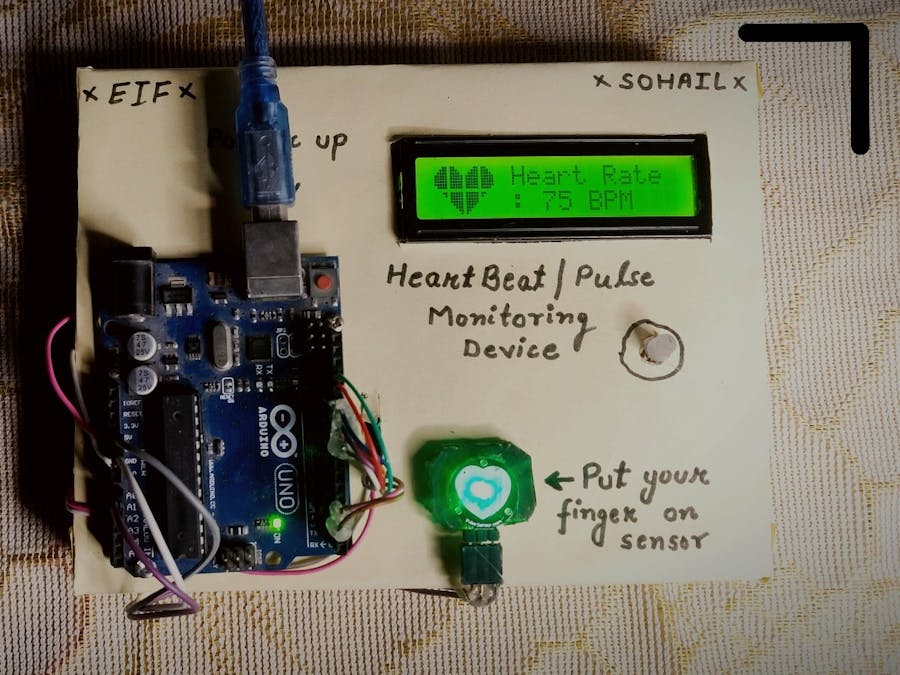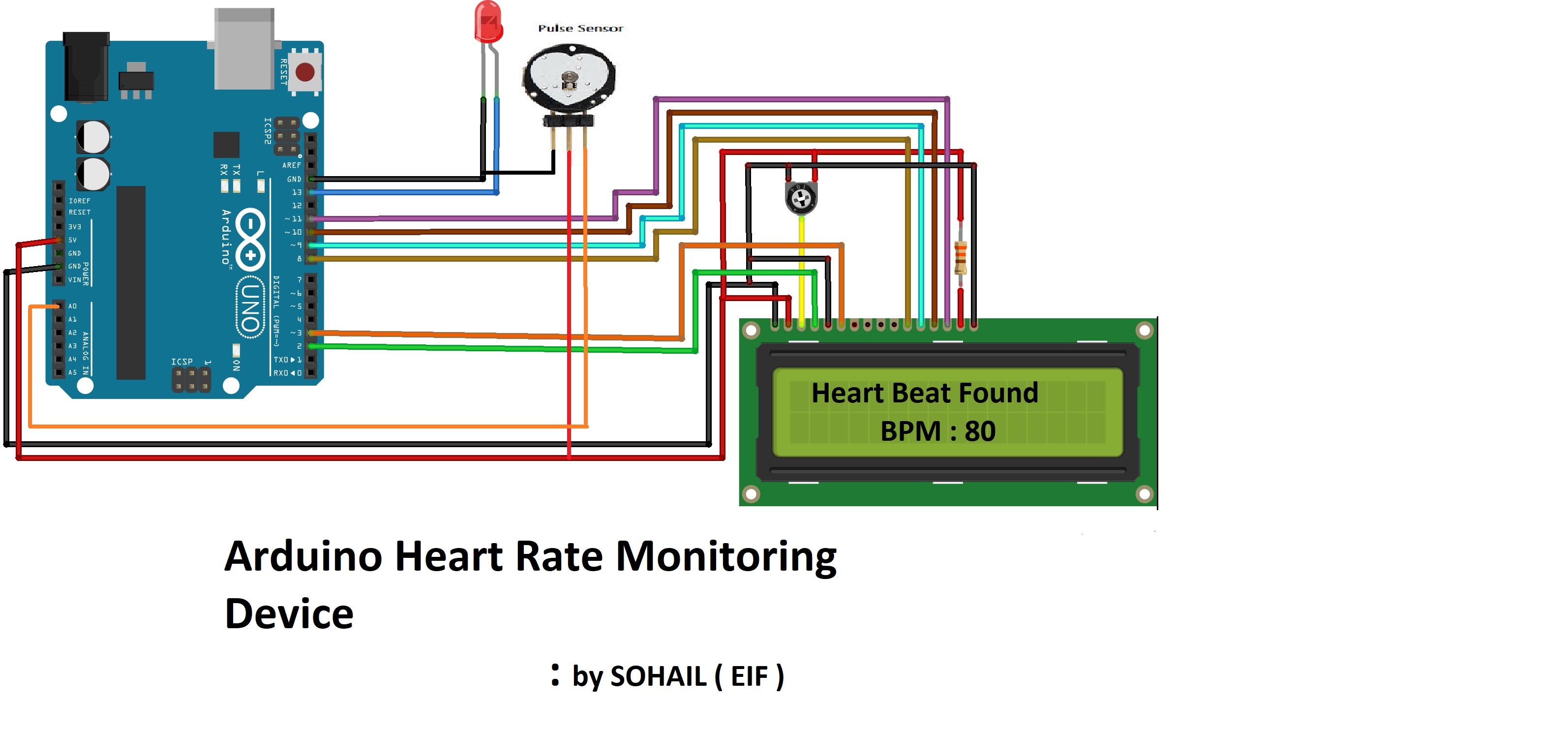// https://www.youtube.com/channel/UCaXI2PcsTlH5g0et67kdD6g //
// HeartBeat / Pulse Monitoring Device //
// By MOHD SOHAIL //
#define USE_ARDUINO_INTERRUPTS true //--> Set-up low-level interrupts for most acurate BPM math.
#include <PulseSensorPlayground.h> //--> Includes the PulseSensorPlayground Library.
#include <LiquidCrystal.h> //--> Includes the LiquidCrystal Library.
LiquidCrystal lcd(2, 3, 8, 9, 10, 11); //--> Initialize LiquidCrystal with "lcd". lcd(RS,E,D4,D5,D6,D7).
const int PulseWire = A0; //--> PulseSensor PURPLE WIRE connected to ANALOG PIN 0
const int LED_3 = 13; //--> LED to detect when the heart is beating. The LED is connected to PIN 3 on the Arduino UNO.
int Threshold = 550; //--> Determine which Signal to "count as a beat" and which to ignore.
//--> Use the "Gettting Started Project" to fine-tune Threshold Value beyond default setting.
//--> Otherwise leave the default "550" value.
//----------------------------------------Draw "Heart" on LCD.
/*
heart4 heart5
=== ===
= 00011 11000 00011 11000 = 11 11 11 11
00111 11100 00111 11100 111 111 111 111
01111 11110 01111 11110 1111 1111 1111 1111
11111 11111 11111 11111 11111 11111 11111 11111
heart3 11111 11111 11111 11111 heart6 11111 11111 11111 11111
11111 11111 11111 11111 11111 11111 11111 11111
11111 11111 11111 11111 11111 11111 11111 11111
= 01111 11111 11111 11110 = 1111 11111 11111 1111
------->
= 00011 11111 11111 11000 = 11 11111 11111 11
00001 11111 11111 10000 1 11111 11111 1
00000 11111 11111 00000 11111 11111
heart2 00000 11111 11111 00000 heart7 11111 11111
00000 01111 11110 00000 1111 1111
00000 00111 11100 00000 111 111
00000 00011 11000 00000 11 11
= 00000 00001 10000 00000 = 1 1
=== ===
heart1 heart8
*/
byte heart1[8] = {B11111, B11111, B11111, B11111, B01111, B00111, B00011, B00001};
byte heart2[8] = {B00011, B00001, B00000, B00000, B00000, B00000, B00000, B00000};
byte heart3[8] = {B00011, B00111, B01111, B11111, B11111, B11111, B11111, B01111};
byte heart4[8] = {B11000, B11100, B11110, B11111, B11111, B11111, B11111, B11111};
byte heart5[8] = {B00011, B00111, B01111, B11111, B11111, B11111, B11111, B11111};
byte heart6[8] = {B11000, B11100, B11110, B11111, B11111, B11111, B11111, B11110};
byte heart7[8] = {B11000, B10000, B00000, B00000, B00000, B00000, B00000, B00000};
byte heart8[8] = {B11111, B11111, B11111, B11111, B11110, B11100, B11000, B10000};
//----------------------------------------
int Instructions_view = 500; //--> Variable for waiting time to display instructions on LCD.
PulseSensorPlayground pulseSensor; //--> Creates an instance of the PulseSensorPlayground object called "pulseSensor"
void setup() {
Serial.begin(9600);//--> Set's up Serial Communication at certain speed.
lcd.begin(16, 2); //--> Initializes the interface to the LCD screen, and specifies the dimensions (width and height) of the display
lcd.createChar(1, heart1);
lcd.createChar(2, heart2);
lcd.createChar(3, heart3);
lcd.createChar(4, heart4);
lcd.createChar(5, heart5);
lcd.createChar(6, heart6);
lcd.createChar(7, heart7);
lcd.createChar(8, heart8);
lcd.setCursor(0,0);
lcd.print("Heart Beat/Pulse");
lcd.setCursor(0,1);
lcd.print(" Monitoring EIF ");
delay(2000);
pulseSensor.analogInput(PulseWire);
pulseSensor.blinkOnPulse(LED_3); //--> auto-magically blink Arduino's LED with heartbeat.
pulseSensor.setThreshold(Threshold);
if (pulseSensor.begin()) {
Serial.println("We created a pulseSensor Object !"); //--> This prints one time at Arduino power-up, or on Arduino reset.
}
delay(2000);
lcd.clear();
}
void loop() {
int myBPM = pulseSensor.getBeatsPerMinute(); //--> Calls function on our pulseSensor object that returns BPM as an "int". "myBPM" hold this BPM value now.
if (Instructions_view < 500) {
Instructions_view++;
}
if (Instructions_view > 499) {
lcd.setCursor(0,0);
lcd.print("Put your finger ");
lcd.setCursor(0,1);
lcd.print(" on the sensor ");
delay(1000);
lcd.clear();
delay(500);
}
if (pulseSensor.sawStartOfBeat()) { //--> If test is "true", then the following conditions will be executed.
Serial.println(" A HeartBeat Happened ! "); //--> Print a message "a heartbeat happened".
Serial.print("BPM: "); //--> Print phrase "BPM: "
Serial.println(myBPM); //--> Print the value inside of myBPM.
lcd.setCursor(1,1);
lcd.write(byte(1));
lcd.setCursor(0,1);
lcd.write(byte(2));
lcd.setCursor(0,0);
lcd.write(byte(3));
lcd.setCursor(1,0);
lcd.write(byte(4));
lcd.setCursor(2,0);
lcd.write(byte(5));
lcd.setCursor(3,0);
lcd.write(byte(6));
lcd.setCursor(3,1);
lcd.write(byte(7));
lcd.setCursor(2,1);
lcd.write(byte(8));
lcd.setCursor(5,0);
lcd.print("Heart Rate");
lcd.setCursor(5,1);
lcd.print(": ");
lcd.print(myBPM);
lcd.print(" ");
lcd.print("BPM ");
Instructions_view = 0;
}
delay(20); //--> considered best practice in a simple sketch.
}




_ztBMuBhMHo.jpg?auto=compress%2Cformat&w=48&h=48&fit=fill&bg=ffffff)













Comments
Please log in or sign up to comment.